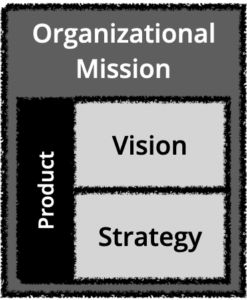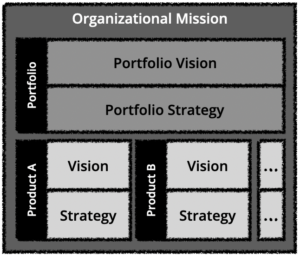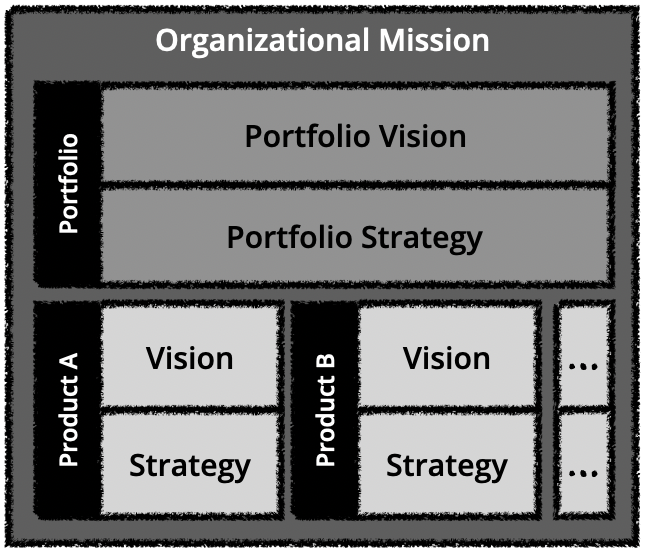Planning in Context: Mission, Vision & Strategy
As a Product Management Consultant I am often asked to review or help guide a team on developing their product roadmap. I have some strong views on the best form roadmaps should take and how they may vary in different stages of the product lifecycle. I believe we can be flexible on how we format and present such roadmaps based on the goals and target audience.
What I am not very flexible on is my belief that you can’t build an effective roadmap without proper context. This article is about that context formed by the Mission, Vision and Strategy.
When having discussions with other internal or external stakeholders around such concepts, I argue that the specific definition is often less important than the fact that all participants are aligned around the same definition. Until you have that alignment you can’t get to efficient communication nor effective execution and learning.
Organizational Mission Statement
The Organizational Mission Statement is an articulation of why the organization exists. The mission is frequently defined by the founders of a startup or the leadership team of an established enterprise. It changes very infrequently. It reflects the top-level guiding ideals and inspiration for the company.
Slack Mission: Making work simpler, more pleasant, and more productive.
Google Mission: Organize the world’s information and make it universally accessible and useful.
Notion Mission: To make a contribution to the world by making tools for the mind that advance humankind.
It is possible to run an organization without a mission statement. However, if you want to inspire and motivate individuals you need a mission that creates an organization of missionaries, in John Doerr’s words.
What distinguishes companies led by mercenaries from those led by missionaries? While the two might seem similar at first glance, they are in fact very different, Doerr points out. “Mercenaries are driven by paranoia; missionaries are driven by passion,” he says. “Mercenaries think opportunistically; missionaries think strategically. Mercenaries go for the sprint; missionaries go for the marathon. Mercenaries focus on their competitors and financial statements; missionaries focus on their customers and value statements. Mercenaries are bosses of wolf packs; missionaries are mentors or coaches of teams. Mercenaries worry about entitlements; missionaries are obsessed with making a contribution. Mercenaries are motivated by the lust for making money; missionaries, while recognizing the importance of money, are fundamentally driven by the desire to make meaning.”
For many organizations the mission is not present in the early days. This is because the founders are focused on a product vision (see below). I believe this can work, however, it often reflects an organization that is more focused on a solution they want to bring to market over building an organization intent on solving problems or addressing needs in the market.
As a startup, hiring great people can be difficult. You lack the safety of an established organization. The mission is one great tool to motivate and inspire like the SpaceX example below.
SpaceX Mission: “You want to wake up in the morning and think the future is going to be great – and that’s what being a spacefaring civilization is all about. It’s about believing in the future and thinking that the future will be better than the past. And I can’t think of anything more exciting than going out there and being among the stars.” -Elon Musk
Very often organizations will create a corporate vision statement with the mission. This vision defines a description of the organization over 5-10 years out. I prefer to keep the vision focused on the product level though. Multiple layers of vision can sometimes confuse the team.
Product Vision
The Product Vision is an articulation of a future state of the product offering often put in the context of customer outcomes it expects to achieve. This articulation is most frequently described in text but it can also be effectively by communicated via mock-ups, drawings, images, or any other media.
Product Vision Board is a template for defining a Product Vision by Roman Pichler. It represents just one way to articulate such a vision.
https://youtu.be/5Dd5f7TFnuk
This product vision is what the team is aiming toward. It is the best guess of the organization on what your solution will look like when it fully solves some market problems. Typically the time horizon is 3-5 years out but will vary based on the specific product category and market dynamics.
While the vision is much narrower in scope than an organizational mission, it is also much more specific and actionable. In early startups a “product visionary” founder is often the originator of this vision but as organizations grow, often it is individual product managers that are given the responsibility of articulating this product vision.
To be most effective, each product team should have a clear product vision that they are aiming toward. Much like envisioning the day you and your spouse retire, you conjure up images and descriptions of exactly what that day will look like. Are you sitting on the beach? Spending lots of time with grandkids? The more details you have the better your ability is to leverage this in planning how to get there.
While the Organizational Mission gives the whole company purpose, the Product Vision gives the product team clarity on a direction that should support the mission.
As you learn more about your market, team, and organization this vision will most certainly evolve. However, it should be a fairly slow evolution after you overcome the rapid learning period during early fuzzy front-end.

Product Strategy
The Product Strategy is how you plan to achieve your Product Vision. A Product Strategy is often articulated as a series of steps you plan to take, with conditions, that continue to move you closer to a vision.
It should be said, that the Product Strategy is conceived within the context of not only the Organizational Mission and Product Vision. It must also take into account more organizational context, such as availability of people, expertise, and alignment with other parts of the organization such as sales, customer success, and marketing.
These steps help the product team in focusing on what must be accomplished (aka goals) now before moving on to the next step of the plan. Those goals usually enable the organization to incrementally expose itself to new risks and discover ways to tackle them without being pulled in too many directions at once.
At times, a goal may be determined to be impossible to reach. This is when the team must adjust their product strategy. Other internal and external factors may impact strategy as well, such as:
-
Changes in the external market, like a pandemic
-
New technology advances
-
Political or regulatory changes
-
Competitive factors
-
A change in Product Vision due to an acquisition
In this regard we can see that the Product Strategy, while it should not change often, must be more adaptable to insights continuously being learned.
How a Product Strategy comes to exist will differ based on how an organization operates. Generally, this is owned by the Product Manager but there will be many stakeholders contributing to it. Frequently, the Product Strategy is officially reconsidered on an annual basis in organizations. This is generally tied to funding decisions that happen largely on a yearly basis.
Forward-looking organizations recognize that insights impacting the strategy are continuously developed. There may also be conditions within an existing strategy that forecast going down alternatives paths due to discovery. As these decisions may have an impact on investment levels, it is a better practice to evolve funding mechanisms that can be responsive to adjustment regardless of when they occur.
Scaling Mission, Vision, and Strategy
The concepts above are great and simple enough to apply within any startup or maturing organization that has a simple organizational structure and portfolio. They do, of course, scale to more complex organizations too.
Organizational Mission – While we might call this the Corporate Mission, I think it is useful to describe it as belonging to an organization. If your business has multiple organizations that are operated independently of each other it may be necessary to define a Mission for each organizational unit. If the mission stops providing clarity of purpose it may have been fractured as the organization grew.
For example Microsoft has diversified in operating segments over the years like Gaming, Business Applications, and Applications & Infrastructure.
Vision and Strategy – Many businesses, including small startups, have multiple products across a portfolio within a single organizational unit. These may be offered together at times but frequently as separate offerings. As such Portfolio Management is introduced where organizations seek to optimize business outcomes across a range of products.
A Portfolio Vision and Strategy are developed to ensure there is intention behind how investments, go-to-market, and other cross organizational attention is focused. Where this exists, each individual Product must sit within the context of such a portfolio view.
As with a Product Strategy evolving as new insights are discovered, the Portfolio Strategy should also evolve over time.

Conclusion
Once you have proper context in place, then can you effectively develop your roadmap. Each of these concepts is likely to give some feedback to the others. For instance, as you execute on your Product Strategy, it is possible to challenge assumptions built into your Product Vision.
As a final note, all of these concepts should be widely shared within your organization in order to free them to become the ideal missionaries. Doing so supports the Agile Manifesto’s Principles of aligned business and technology teams who are motivated towards shared goals. Further, setting clear context enables maximum innovation and trust that powers the “self-organizing teams” popularly defined in Scrum.
Recommendations
-
Missionary vs. Mercenary with John Doerr, KPCB.
-
Start with Why by Simon Sinek. The classic talk on “Why” and how leaders use it to inspire action. The “Why” is very much aligned with the Organizational Mission although Sinek is more focused on inspiring the external market rather than a team of missionaries.
-
Product Strategy series on the SVPG Insights Blog by Marty Cagan. I only touched upon Product Strategy in this article. For some great thinking around Strategy in more detail I recommend checking out this 5 article series.
